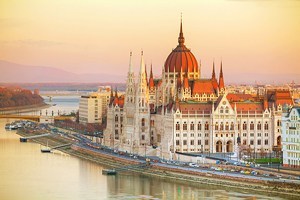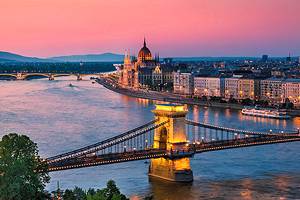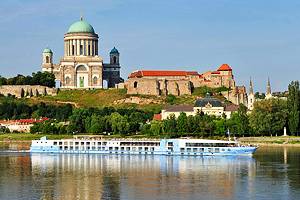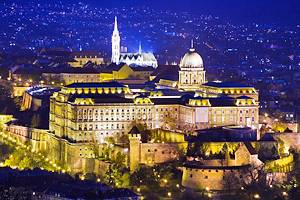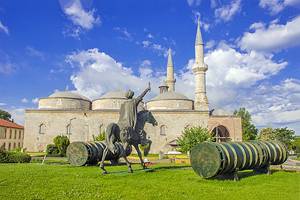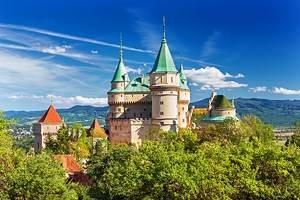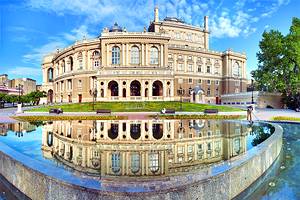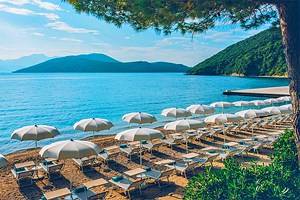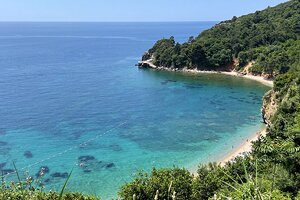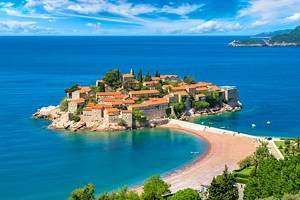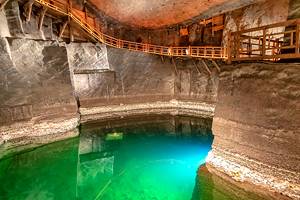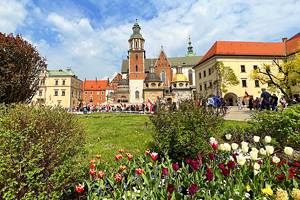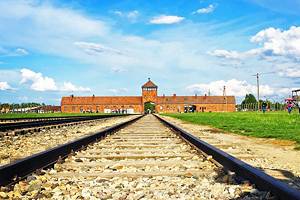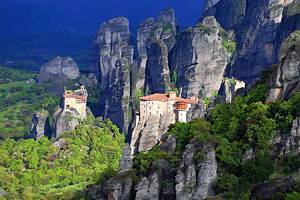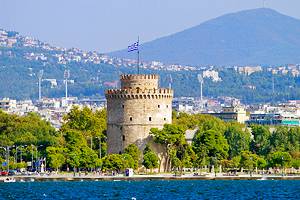13 Top-Rated Attractions & Things to Do in Bucharest
Once known as "Little Paris" for its elegant architecture, Romania's capital of Bucharest is rich with a storied history that merges with its modern identity.
The confluence of architecture is dizzying yet fascinating. Its Byzantine buildings; 16th-, 17th-, and 18th-century churches; Art Nouveau mansions; and spectacular Neoclassical facades have survived earthquakes, war, and later, communism – and they all mix together to create a breathtaking urban display.
During that dark political era, somber block panel masonry left its imprint, as well as the gargantuan Palace of the Parliament, the prized creation of dictator Nicolae Ceausescu.
The charm of Bucharest is revealed by exploring its sprawling city parks, admiring the works of art and exhibits at its excellent museums, and getting lost in the gritty yet charming lanes that weave through the Old Town.
A stroll down Calea Victoriei, arguably one of the prettiest places to visit in the city, is an encounter with the country's grandest buildings and most meaningful monuments, all a testament to times gone by.
Exploring Bucharest is about understanding a complex past that is giving way to its modern sensibility as a booming European capital. Discover the best places to visit in this dynamic city with our list of the top attractions and things to do in Bucharest.
- 1. The Old Town
- 2. Palace of the Parliament
- 3. Romanian Athenaeum
- 4. Stavropoleos Church
- 5. Curtea Veche: The Old Princely Court
- 6. Revolution Square
- 7. Arcul de Triumf
- 8. National Museum of Art of Romania
- 9. Dimitrie Gusti National Village Museum
- 10. National Museum of Romanian History
- 11. Bucharest Parks
- 12. Carturesti Carusel
- 13. Day Trip to Bran Castle
- Where to Stay in Bucharest for Sightseeing
- Map of Attractions & Things to Do in Bucharest
1. The Old Town
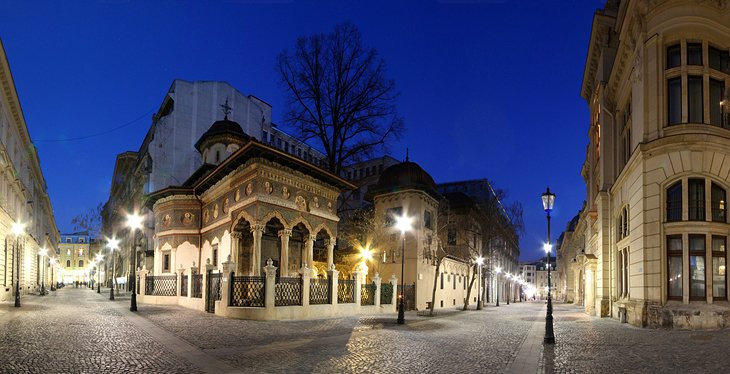
The Old Town is one of Bucharest's earliest settlements, where structures date back to the 15th and 16th centuries. Over the centuries, it has been the seat of Romanian princes, a center for trade, a place to worship, and a crossroads for travelers.
It also managed to survive Ceausescu's 1980s razing of one-fifth of the city to build his vision of a new Socialist capital. After spending decades as a slum, much of the Old Town has been gentrified and renovated since the fall of communism.
Yet while many historic buildings have been gallantly restored, still other properties await their facelift. This contrast gives that much more charm to the Old Town's pedestrian lanes and cobbled streets lined with bookshops, theaters, restaurants, and cafés.
Popular things to do here include visiting Curtea Veche, an open-air museum built on the site of the Old Princely Court, once home to Vlad the Impaler, and the National Museum of Romanian History with its fine collections of religious and royal treasures.
2. Palace of the Parliament
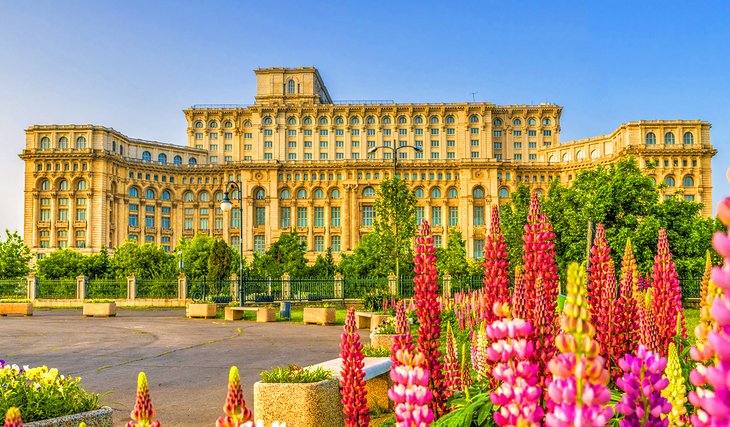
The Palace of the Parliament (Palatul Parlamentului) is one of the top tourist attractions in Bucharest. It is the world's second-largest administrative building (after the Pentagon), an architectural colossus that also claims the title as the heaviest building in the world.
Boasting more than 3,000 rooms over 330,000 square meters and constructed with marble and steel, it was originally called the People's House by its visionary, the dictator Nicolae Ceausescu, who used it as his family's residence and as the seat of his government.
To complete it, Ceausescu razed places of worship, workshops, factories, parks, part of the Old Town, and entire neighborhoods. More than 20,000 workers and 700 architects worked on the opulent Neoclassical-style palace over a span of 13 years, from 1985 to 1997, during which time the majority of Romanians faced poverty.
Still unfinished, today a small portion houses Romania's parliamentary headquarters and the National Museum of Contemporary Art. Scheduled tours bring visitors up close to its vastness, the kitsch, and the outrageous luxury Ceausescu would have continued to experience had he not been overthrown in a coup d'état.
Address: Strada Izvor 2-4, Bucharest
3. Romanian Athenaeum
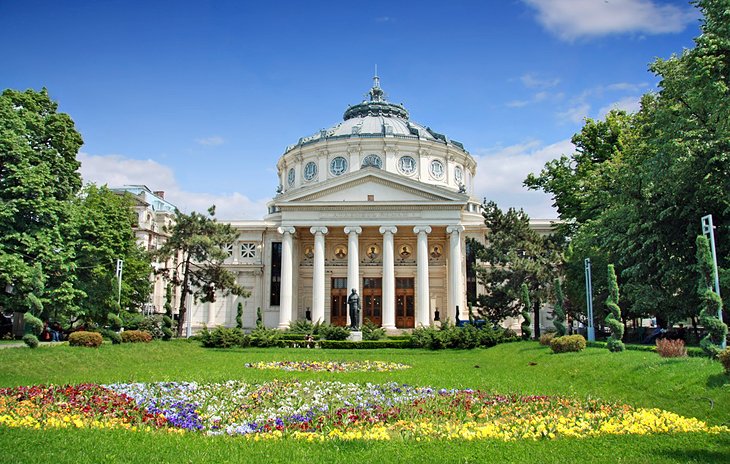
Home to the George Enescu Philharmonic Orchestra, the stately Romanian Athenaeum (Ateneul Român) is the city's most prestigious concert hall. The 19th-century building, designed by French architect Albert Galleron, resembles an ancient Greek temple with a 41-meter-high dome and a peristyle of six Ionic columns.
The interiors feature a lobby of intricately painted gold-leaf ceilings, cascading balconies, and spiral marbled staircases. The 652-seat auditorium is known for its excellent acoustics and its fine art. A 70-meter-long and three-meter-high fresco that winds its way around the circular hall proudly depicts scenes from Romania's history.
Address: Strada Benjamin Franklin 1-3, Bucharest
Official site: www.fge.org.ro/en
4. Stavropoleos Church
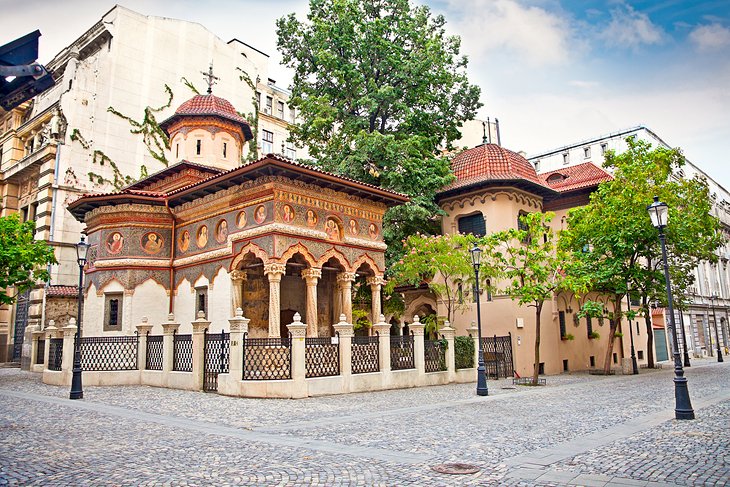
Tiny, peaceful, and beautiful, the Stavropoleos Church (Manastirea Stavropoleos) was built in 1724 by a Greek monk, Ioanikie Stratonikeas. With its intricately carved entrance lined with columns, this Brâncovenesc-style church stands apart as a unique landmark in Bucharest.
The Orthodox church features fine stone and wood carvings and a combination of Romanian and Byzantine elements. It is surrounded by a garden courtyard filled with 18th-century tombstones.
Inside, several frescoes and wood icons can be admired. The church complex once included an inn and a monastery but both were destroyed. The church itself was restored several times after damage from earthquakes, and is noted for its unique library that houses a large collection of books related to Byzantine music.
Be sure to check the church's websites for news of concerts and other events, which are available to the public.
Address: Strada Stavropoleos 4, Bucharest
5. Curtea Veche: The Old Princely Court
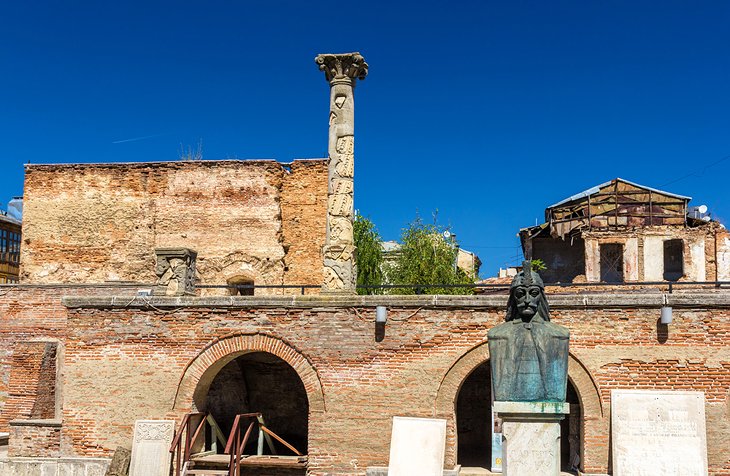
Located in the heart of the Old City, the Old Princely Court (Curtea Veche) was the palatial residence of Wallachian princes. Perhaps its best-known occupant was Vlad Tepes, otherwise known as Vlad the Impaler, who inspired Bram Stoker's tale of Dracula. A statue of the infamous Romanian prince stands among what's left from the past, including the court's walls, several arches, and columns.
A 16th-century prince, Mircea Ciobanul, repaired the palace after Vlad the Impaler's rule, and he grew the surrounding Lipscani area as the trading core of Bucharest by establishing a community of skilled craftsmen.
In 1559, Ciobanul built the Old Princely Court Church next to the palace. For the two centuries that followed, it was the place for succeeding Romanian princes to be coronated.
Also worthy of a visit is the Old Court Museum, which features pottery and artifacts found during an archaeological dig around the ruins.
Address: Strada Franceza 25-31, Bucharest
6. Revolution Square
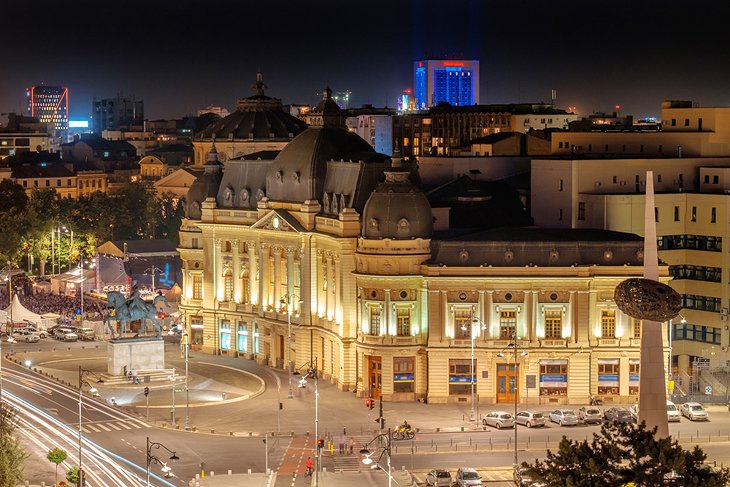
Revolution Square (Piata Revolutiei) earned its name after setting the scene of dictator Nicolae Ceausescu's final minutes of power in Romania. On December 21, 1989, a coup d'état ensued here with the help of a crowd of more than 100,000, forcing the leader of the communist party to flee and changing the course of the country's history.
Until that date, the central square was known as Palace Square, due to its proximity to the Royal Palace, which is the current home to the National Museum of Art.
Other historic buildings stand nearby, including the Senate Palace, the Romanian Athenaeum, and the Athenee Palace Hilton Bucharest.
Revolution Square is also known for the dramatic Monument of Rebirth. Erected in 2005, it includes the names of the 1,058 victims of the bloody revolution and a bronze statue of Iuliu Maniu, the Romanian prime minister imprisoned by the communist party.
Address: Calea Victoriei Boulevard, Bucharest
7. Arcul de Triumf
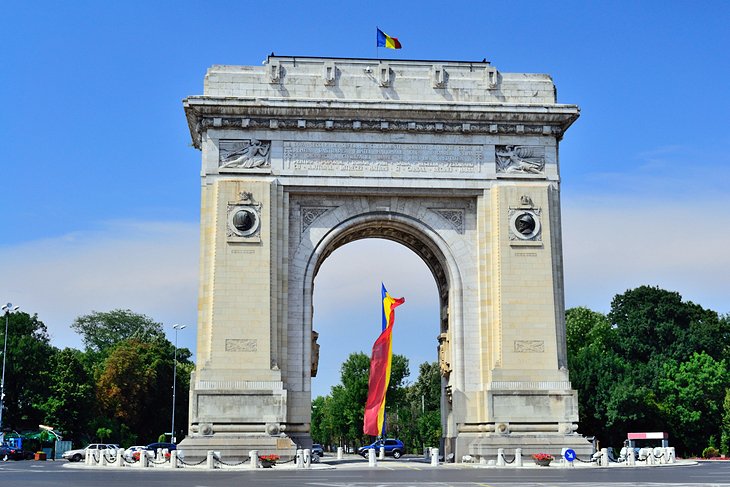
Finished in 1878, Bucharest's first Arch of Triumph (Arcul de Triumf) was made from wood and dedicated to the Romanian soldiers who fought in World War I. In 1936, it was reconstructed in granite and designed by architect Petre Antonescu at a height of 27 meters. The arch is adorned with sculptures created by the most notable Romanian sculptors, including Ion Jalea and Dimitrie Paciurea.
To this day it continues to serve its purpose of being the central point for military parades. Romanian soldiers march beneath it for big events, including each December 1st, which is the country's national holiday.
Address: Kiseleff Road, Bucharest
8. National Museum of Art of Romania
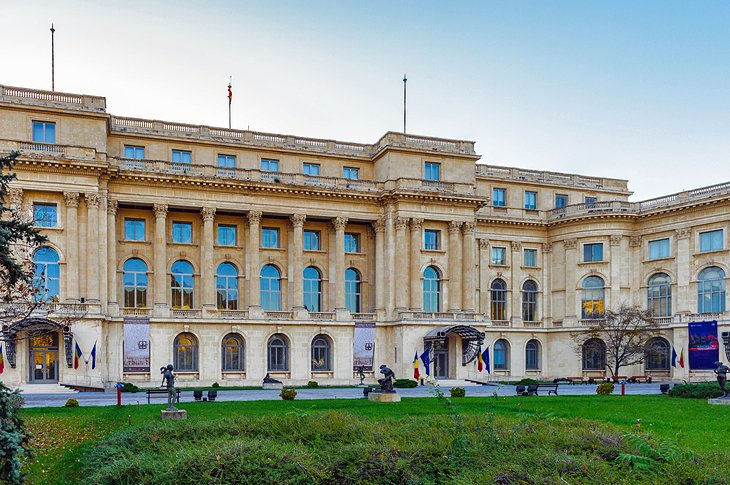
Housed in the former Royal Palace, the National Museum of Art of Romania (Muzeul National de Arta al României) is the country's leading art museum and houses the world's most complete collection of Romanian art, including medieval and modern art.
Established in 1948, the museum is also where the Royal Collection, including Romanian and European art dating back to the 15th century, can be admired. More than 100,000 works are in the various halls, including paintings by the country's most celebrated artists, Theodor Aman, Nicolae Grigorescu, and Gheorghe Tattarescu.
The modern Romanian collection features sculptures by Milita Petrascu and Dimitrie Paciurea. One room is dedicated to Constantin Brancusi, one of the most influential sculptors of the 20th century. The European Gallery next door has 15 rooms including works by El Greco, Monet, Rembrandt, Renoir, and Rubens.
Address: Calea Victoriei 49-53, Bucharest
Official site: www.mnar.arts.ro/en/
9. Dimitrie Gusti National Village Museum
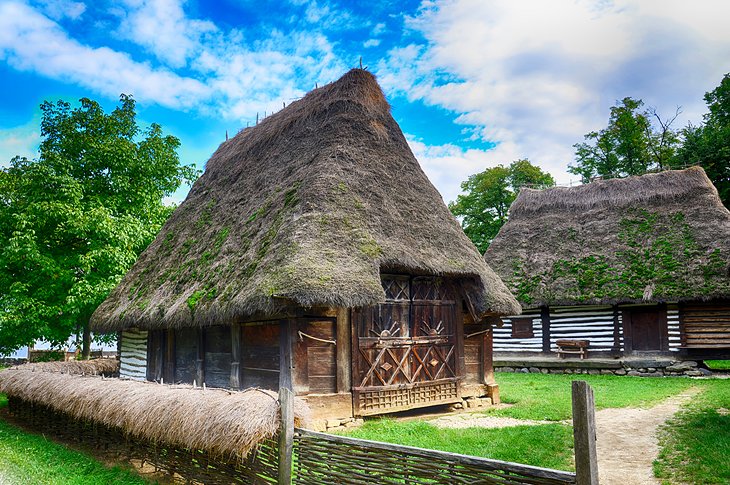
Founded in 1936, the Dimitrie Gusti National Village Museum – usually shortened to simply the "Village Museum" (Muzeul Satului) – is a unique open-air museum that stretches through leafy Herastrau Park and depicts the traditional way of life in Romania.
Visitors can wander through 300 traditional buildings, including peasant homes with steep roofs, thatched barns, heavy log cabins, various types of churches, workshops, and mills – all of which have been transported from towns across every region of Romania.
Each building was carefully taken apart, shipped to the museum, and rebuilt to be part of the walkable village-like setting in the park. The Village Museum also displays artifacts and pottery, as well as other traditional items hailing from around the country.
Address: Sos. Kiseleff 28-30, Herastrau Park, Bucharest
10. National Museum of Romanian History
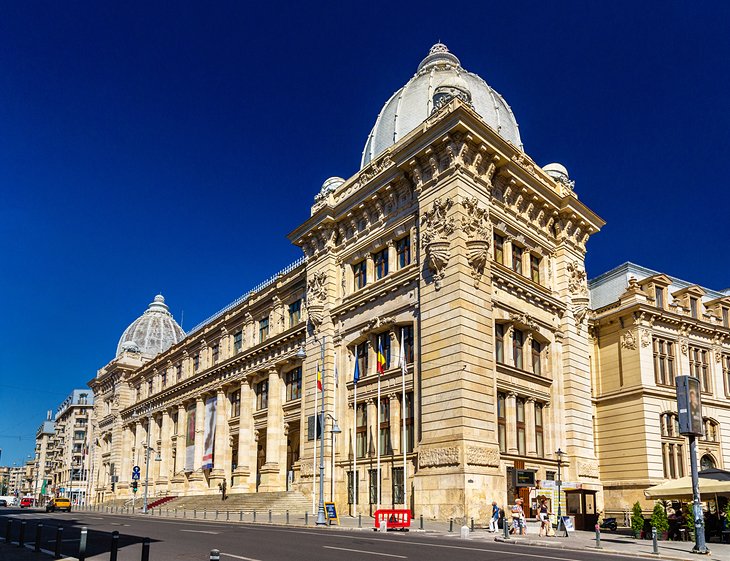
The National Museum of Romanian History (Muzeul National de Istorie a României) is set in an attractive Neoclassical building originally built for the Romanian postal service. Since 1970, the museum's 60 rooms have displayed the country's most fascinating historical exhibits dating from prehistoric to modern times.
The biggest permanent exhibit is a huge replica of the 2nd-century Trajan's Column, built in honor of the conquering Roman emperor Trajan, who defeated Romania's ancient Dacian tribes.
Thousands of gold items and Neolithic artifacts, including jewelry dating to the time of the Geto-Dacians, can be found in the Romanian Treasury. On permanent display are the Romanian Crown Jewels, including stunning emerald pieces made for Queen Marie, who was the wife of Romanian King Ferdinand.
Also here are gold artifacts from the 4th-century Pietroasele Treasures. It was once considered the most valuable treasure collection in the world before Tutankhamen's tomb was unearthed.
The Grigore Antipa National Museum of Natural History (Muzeul National de Istorie Naturala Grigore Antipa) – usually referred to simply as the Antipa Museum – should also be included in your list of Bucharest places to visit. Recently refurbished, it houses everything from interactive exhibits to traditional displays of animal species from around the world.
Address: Calea Victoriei 12, Bucharest
11. Bucharest Parks
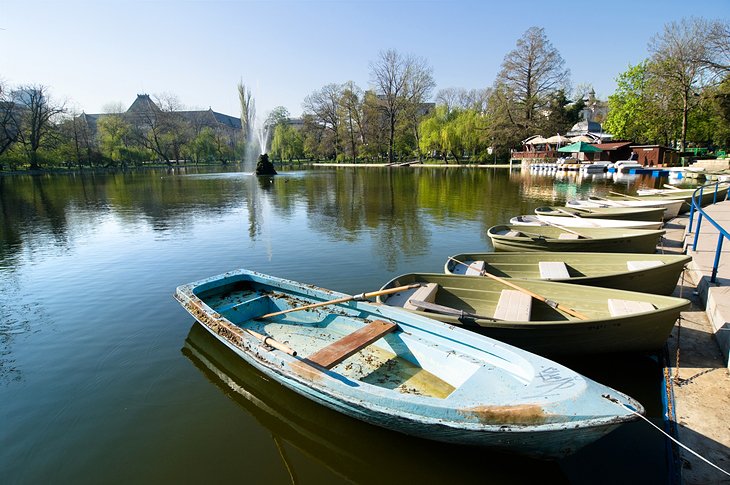
Bucharest is swathed in beautiful parks that are frequented by locals year-round. The oldest city park, designed in the mid-19th century, is Cismigiu Gardens. Renting rowboats is one of the most popular things to do here in the summer, and the ice rink is popular in winter.
German landscape architect Carl Meyer designed the park, which opened in 1860, bringing in 30,000 trees and plants from the Romanian mountains and greenery from botanical gardens in Vienna.
Spread over 400 acres, King Michael I Park is home to the Dimitrie Gusti National Village Museum, an open-air theater, sports club, and an old-fashioned amusement park. At its lake, boat rentals are available to the public every summer. Bordering the park, 19th- and 20th-century villas are the homes of Bucharest's elite.
Designed by French landscape artist Eduard Redont and completed in 1906, Carol Park is considered one of the most beautiful parks in the capital. Romania's Tomb of the Unknown Soldier is located here as well as a Roman-era styled open-air theater called Arenele Romane, which is popular for summer concerts.
Also worth exploring, the Bucharest Botanical Garden (Gradina Botanica din Bucuresti) was established in 1860. It is spread across 17 hectares and boasts more than 10,000 different species of plants. Highlights include its numerous greenhouses, an informative museum, and plenty of flower beds to enjoy.
12. Carturesti Carusel
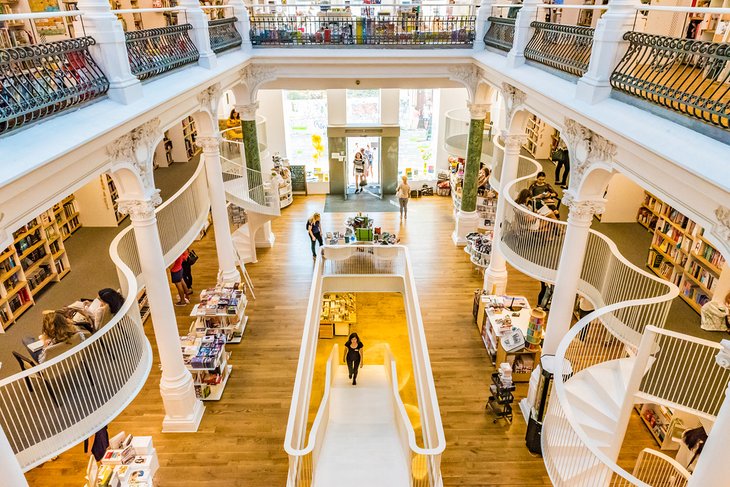
Set inside a beautifully restored 19th-century building in the center of the Old Town is the city's most impressive bookshop, Carturesti Carusel. This 1,000-square-meter shop is spread across six floors, with shelves stocked with more than 10,000 books, as well as 5,000 albums and DVDs.
Its design is impressively minimal, playing with light that filters through a central skylight, creating an atmosphere that is like a moving carousel, hence its name, which literally translates to "Carousel of Light."
The bookshop is a local hub, not only for reading and browsing through books, but for art and relaxing. Carturesti Carusel is also frequented for its changing contemporary art displays, media center presentations, and welcoming top-floor bistro café.
Address: Strada Lipscani 55, Bucharest
13. Day Trip to Bran Castle
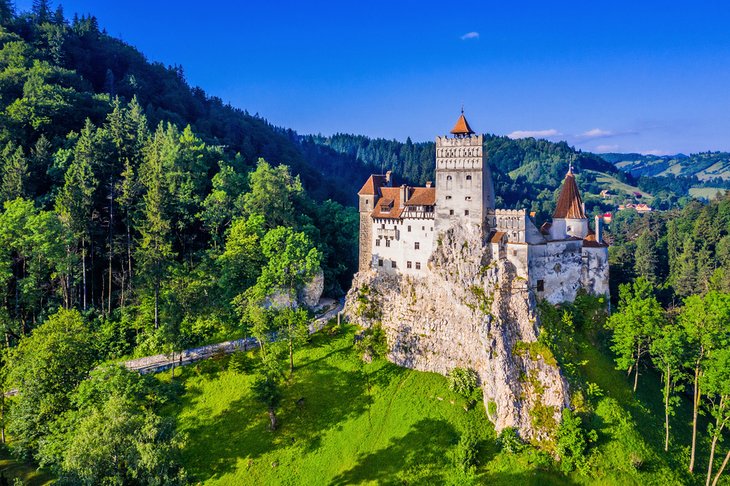
Bucharest is the starting point for one of the most popular day trips from Bucharest: Bran Castle. Better known internationally as Dracula's Castle, this national monument was built in the 14th century and likely had nothing to do with the fictional Bram Stoker character. In fact, there's no evidence that Stoker even knew the castle existed – or proof that Vlad the Impaler (the inspiration for Dracula) ever visited the castle.
Still, the dramatic and haunting castle – which sits on a hill against thick forests often enveloped in fog – remains one of the most iconic visual representations of Romania, and it's well worth a visit. Now a museum displaying period furniture and objects that once belonged to Queen Marie, the castle also tells visitors about Vlad the Impaler and offers access to towers, narrow passageways, and spooky staircases.
The 14th-century Rasnov Fortress is just minutes away from the castle and is a masterwork of engineering, featuring nine towers, over 30 houses, a chapel, and many other buildings.
Visitors can also make their way to the nearby open-air Ethnographic Museum of Transylvania, featuring 90 buildings reflecting the lifestyle of rural Transylvania. These include everything from mills to wooden churches.
Where to Stay in Bucharest for Sightseeing
Luxury Hotels:
- The highly rated, 5-star Epoque Hotel should certainly be at the top of your list of luxury hotels in Bucharest. An easy walk from things to do, such as taking in an opera or classical concert at the Romanian Athenaeum and popular city parks, the Art Nouveau design of the building adds to the hotel's chic appeal. A variety of room options are available, including spacious suites with separate living rooms, kitchenettes, and balconies or terraces.
- The luxurious JW Marriott Bucharest Grand Hotel is another 5-star offering to check out (and into). Located close to top city attractions, including the opulent Palace of the Parliament, this luxury hotel features classy rooms with separate seating areas and posh marble bathrooms, with an option to upgrade to larger suites with pullout couches. Amenities include a choice of five restaurants plus a café, outdoor dining, an indoor pool, and spa.
- The modern-looking InterContinental Bucharest is another contender. Close to many of the city's top tourist attractions, the InterContinental's largest suites come with big bathrooms, with whirlpool tubs, and living rooms. Notable amenities include on-site dining, a spa, fitness center, and indoor swimming pool overlooking Bucharest.
Mid-Range Hotels:
- The Hilton Garden Inn Bucharest Old Town is at the high-end of the mid-range hotel category. Highlights of the hotel's accommodation choices include modern rooms and suites, some with pullout couches, within an easy walk of the city's top attractions. On-site things to do include dining and working out in the fitness center.
- Popular for its proximity to city transit, Athina Suites Hotel features spacious one- and two-bedroom units with balconies and bright, modern décor. Guests are treated to a great breakfast buffet in the on-site restaurant.
- Hotel Christina also comes highly recommended. Situated near good restaurants, cafés, and entertainment options, the casual rooms are clean and comfortable and come with coffee machines and free Wi-Fi (be sure to request a room with a balcony if available). A buffet-style breakfast is included with your stay.
Budget Hotels:
- A quirky budget accommodation set in an old home, Good Living Bucharest Hotel consists of just six units – three double rooms and three apartment-style suites. In addition to its shared kitchen, guests also have access to shared living areas. The hotel is also popular for its proximity to the historic Old Town area, just a 15-minute walk away.
- The Little Bucharest Old Town Hostel is a great choice for those on a tight budget who don't mind sharing. Centrally located in the historic Old Town sector of the city, rooms are mixed-gender and come with linens and lockers. A number of private rooms are also available and come with their own bathrooms. A kitchen and lounge area is available for guests to use.
- Also fun for backpackers, the cool Podstel Bucharest features great shared rooms (plus one private room) close to the city's top attractions. Laundry service is available, along with luggage storage, and free parking.
Map of Attractions & Things to Do in Bucharest
More Related Articles on PlanetWare.com
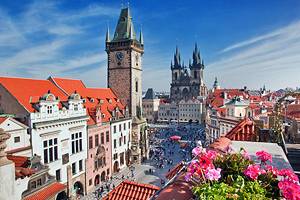
Exploring Eastern Europe: Beautiful Bucharest makes for an excellent jumping-off point for other equally attractive city destinations in Eastern Europe. The Hungarian capital of Budapest is among the most visited cities in Europe, and offers plenty to do, from enjoying its tourist attractions to relaxing in the spas built upon its thermal springs. One of the top places to visit here is Castle Hill, which dominates Buda Old Town and offers superb views over the Danube. Then, of course, there's magnificent Prague, a "city of a thousand spires" that also makes a great jumping-off point to explore other areas of the Czech Republic.


